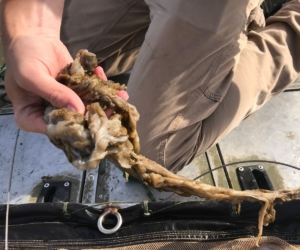Invasive Species
Invasive species are a detriment to the Great Lakes ecosystem. Learn more about how CFRE is studying and combatting them below.
European Frog-Bit
European frog-bit (EFB) is a free-floating plant native to Europe and Asia that has invaded Michigan waters. It is considered an invasive species. EFB is known to form dense mats and presumably has adverse effects on native species, but our ecological understanding of EFB in the Great Lakes is in its infancy. EFB was first detected in the St. Marys River in 2010, but has since become established throughout Munuscong and Raber bays.
Our research focuses on identifying habitat characteristics most associated with EFB infestation, assessing the responses of plants, macroinvertebrates, and fishes, and hand removal of EFB in coastal wetlands of the St. Marys River.
Learning to Manage Rock Snot (Didymo), an Ecologically Disruptive Diatom, in Michigan Waters
Rock Snot, scientifically known as Didymosphenia geminata (Didymo), is a stalk-producing diatom that was first observed blooming in the St. Marys River in 2015. This was the only record of a Didymo bloom in Michigan waters and, to date, blooms have persisted, but very little is known about this nuisance diatom in the region.
CFRE scientists and students, along with US (University of Wisconsin-Oshkosh) and Canadian (Gespe’gewaq Mi’gmaq Resource Council) partners, are conducting research to understand the spread of Didymo in the region, the vulnerability of other nearby waters to being invaded by Didymo, and the environmental conditions that trigger nuisance blooms.



